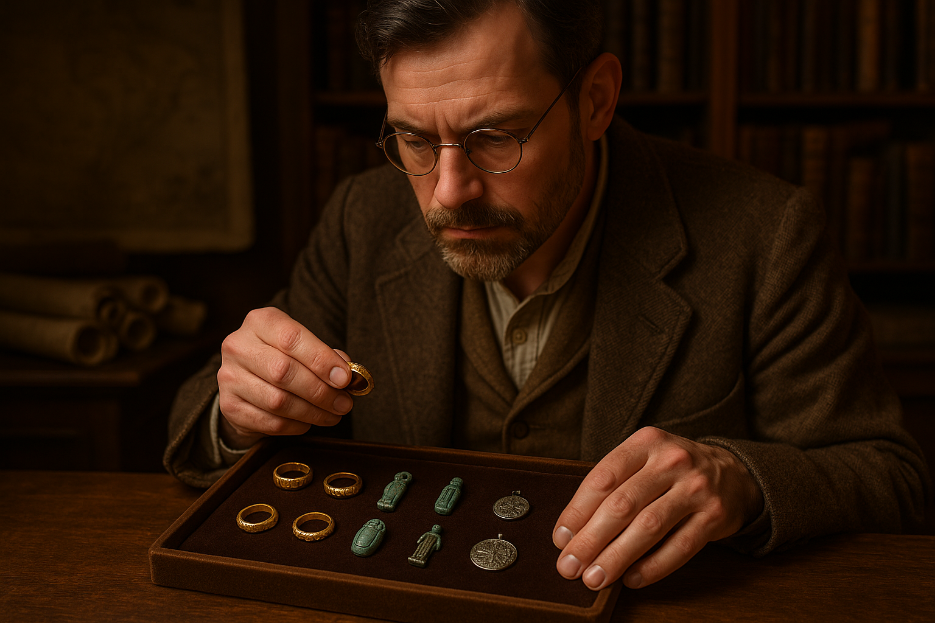Buying Ancient Jewelry Online: A European Collector’s Checklist
Why Buying Ancient Jewelry Online Appeals to European Collectors
In recent years, ancient jewelry has seen a growing demand among collectors across Europe. From Roman gold rings to Egyptian amulets, these exquisite pieces hold not only artistic and aesthetic value but also deep historical significance. For the discerning European collector, owning such jewelry offers a tangible connection to the civilizations that shaped the continent’s identity.
But with that demand comes the challenge of navigating a digital marketplace that includes both authentic and questionable listings. This guide is designed to help you evaluate ancient jewelry online with confidence — especially when shopping from reputable dealers like Acropolo.com.
Whether you're a first-time buyer from Paris or a seasoned collector in Berlin, this checklist will ensure your next ancient acquisition is a rewarding and trustworthy experience.
Checklist for Buying Ancient Jewelry Online
1. Verify the Authenticity of Ancient Jewelry Online
Authenticity is the foundation of any valuable ancient piece. Authentic ancient jewelry is thousands of years old and carries the hallmarks of period-specific craftsmanship. Always ensure:
- Provenance: The piece’s origin should be clearly documented. At Acropolo, each item includes historical information and estimated dating.
- Expert Verification: Reputable sellers should work with certified archaeologists or artifact appraisers.
- Material Aging: Gold, silver, and bronze age in specific ways. Look for natural patina, minor wear, or mineral encrustation.
🔗 Example: Ancient Roman Gold Earrings (200 AD) — With detailed origin and time period provided.
2. Understand the Cultural and Historical Context
Knowing what a piece represents can significantly enhance its value — both monetary and emotional. European collectors often gravitate toward jewelry from:
- Ancient Rome & Greece: Representing power, mythology, and refined metalwork.
- Byzantine Empire: Known for religious symbolism and gem-inlaid rings.
- Ancient Egypt & Levant: Popular for protective amulets, scarabs, and funerary jewelry.
🔍 Consider:
Would you prefer a Roman signet ring used by a senator? Or a Ptolemaic ring possibly worn during Cleopatra’s reign?
🔗 Featured: Ancient Egyptian Ptolemaic Hippopotamus Ivory Ring (Cleopatra?, 40 B.C.)
3. Evaluate Materials and Craftsmanship
Not all ancient jewelry is made equal. While many pieces used gold and silver, others incorporated semi-precious stones like carnelian, garnet, or glass beads. Look for:
- Metal Purity: Ancient gold often had a higher natural gold content due to limited refining technology.
- Hand-carving Techniques: In intaglios or scarabs, detailed imagery reveals quality.
- Unique Stone Setting Styles: Romans, for instance, used bezel settings commonly.
🔗 Explore: Roman Silver Ring with Carnelian Stone
4. Watch for Restorations and Repairs
Some pieces have undergone restoration to stabilize them for sale. Restoration isn’t inherently negative, but it should be disclosed and priced accordingly.
Questions to ask:
- Has the piece been restored or reinforced?
- Were modern materials used in the repair?
- Is the restoration reversible?
Acropolo includes condition reports that highlight whether pieces are fully intact or stabilized using reversible techniques.
5. Think Investment, Not Just Decoration
Ancient jewelry often appreciates in value — particularly if its authenticity is unquestionable and its provenance solid. For European buyers, artifacts tied to local historical events or empires may carry added significance.
Tips:
- Consider timelessness over trendiness.
- Prioritize wearable artifacts in excellent condition (rings, earrings, beads).
- Document your purchase and store paperwork safely.
Featured Investment-Grade Item:
Ancient Roman Gold Earrings Set (4 pcs, 100–200 A.D.)
6. Shipping, Taxes & Legal Considerations
When purchasing across borders, be aware of:
- VAT or import duties depending on your country.
- Legal export licenses — Acropolo only lists items cleared for international shipping.
- Shipping insurance — Always opt for tracked, insured delivery.
📦Acropolo ships internationally and works with customs brokers to ensure smooth delivery for European collectors.
7. Choose Trusted Sellers When Buying Ancient Jewelry Online
A high-quality ancient jewelry vendor should:
- Offer a clear return/refund policy.
- Be responsive to authentication inquiries.
- Have a professional, cataloged site (not just listings on eBay or Etsy).
Acropolo.com offers:
- 100% guaranteed authenticity.
- SSL-secured checkout.
- Curated inventory vetted by experts.
🔗 View the Full Ancient Jewelry Collection
Buying ancient jewelry online can be an incredibly fulfilling journey — especially for European collectors who feel a cultural bond with the Roman, Byzantine, or Egyptian empires. When you follow a thorough checklist, you’re not just buying a necklace or ring — you’re acquiring a chapter of human history.
With the right approach and a trusted seller, your collection can grow into a legacy that reflects both taste and scholarship.
Ready to Begin Your Journey?
Whether you’re seeking a museum-worthy Roman ring or a delicate Byzantine infant bracelet, Acropolo.com offers authentic ancient jewelry backed by expertise and ethical sourcing.
👉 Start Your Collection Today
👉 Have Questions? Contact Our Artifact Experts

